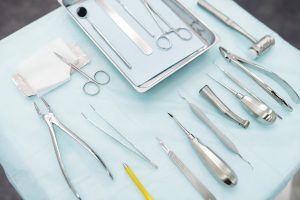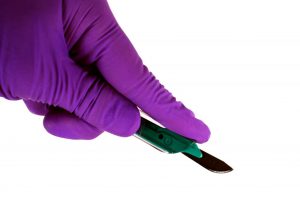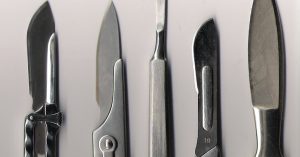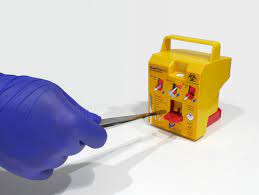Are Safety Scalpels Actually Safe?
Injuries from needles and scalpels are one of the biggest concerns among health care workers with upwards of 18,000 healthcare workers in Australia experiencing needle-stick and scalpel injuries each year (1). Hazards from sharps injuries include transmission of Hepatitis B, Hepatitis C and HIV, as well as 20 other pathogens (1). This is not to mention psychological and physical distress experienced by injured personnel (1). However, costs associated with sharps injuries should not only be a cause concern for health care workers. Injuries to staff can be costly for health care facilities, reaching a cost per sharps injury of $3000 USD for high-risk exposure follow-up, or up to $1,000,000 USD in the case of a serious infection (2).

Safety-engineered devices
Safety-engineered devices are specifically designed to reduce the risk of these injuries. Medical Technology Association of Australia (2013) estimates that implementation in all hospitals could potentially prevent over 80% of needle-stick and scalpel injuries, accompanied by an average of $18.6 million in cost savings per year. To help calculate the cost savings of implementing scalpel safety in your organisation, Qlicksmart has developed a value analysis calculator.
These devices can be categorised as either passive or active. Activation of passive devices occurs automatically without user involvement and typically only requires single-handed use (3). Active safety devices require manual activation of the safety mechanism by the user, such as pressing a button, sliding a shield or snapping a cap (4). As scalpels have been found to be the second highest cause of injuries in operating settings, safety scalpels and scalpel blade removal devices are two such safety-engineered devices aiming to reduce sharps injury rates (5).
Safety scalpels
Although it has previously been thought that safety scalpels improve sharps safety, evidence suggests this may not be the case (6). In a 2013 systematic review, no evidence supporting the use of safety scalpels was found (7). Similarly, from EPINet data across 1993 – 2001, reusable and disposable scalpels were the third highest cause of sharps injuries across all healthcare settings (8). There are a number of reasons why this may be the case.

Why safety scalpels do not necessarily improve sharps safety
Safety scalpels may provide a false sense of security to the end-user, which can compromise use of the safety feature and interrupt proper disposal of the device. Authors of a 2018 study from the Netherlands state that safety features often result in incorrect disposal of needles and unsafe safety-engineered device handling, which may be due to lower perceptions of injury risk (9). This is of particular concern, given that one third of needle-stick and scalpel injuries have been found to be associated with improper disposal (10).
Active devices such as safety scalpels are also more prone to human error causing incorrect activation of safety mechanisms. It was found that 35% of sharps injuries occurred while a safety-engineered device was being used in a 2020 German study, and it is suggested that this may be due to failed activation (10). Failure to properly activate a safety mechanism greatly undermines safety, with improper activation accounting for almost 3 in 4 injuries in a recent retrospective review of percutaneous injuries using EPINet data from 2001-2009 (11). As surgical environments are often complex, and involve a high degree of concentration, active devices may not be suitable.
Finally, safety scalpels suffer from low adoption rates among surgeons (3). For example, in 30 hospitals across Australia and the United States, 98% of surgeons reported a dislike of safety scalpels, indicating a stronger preference for traditional scalpel handles. Reasons for low adoption include disruption to balance, vision and range of choice (3). Also, unexpected patient movements or emergency situations may not accommodate proper activation of a mechanism (10).

Advantages of passive safety devices
Passive devices appear to be a better solution to sharps injuries reduction, as they reduce human-related errors and require less manipulation of the mechanism. Compared to active devices, passive devices have been found to be most effective in reducing needle-stick injury incidence rates (12) . Of the active devices examined, those with semiautomatic safety features (push bottom or plunger) were more effective than those requiring manual activation of toppling shields or sliding shields (12).
Current recommendations
Therefore, it is evident that safety scalpels are not necessarily a safer option, particularly in operative settings. Not only do they provide a false sense of safety, leading to incorrect disposal, however they also suffer from incorrect activation and low adoption rates. As an alternative to safety scalpels, the use of both a single-handed blade remover, as well as a neutral hands-free passing technique appears to be current best practice. This combination can be 5 times safer than inconsistently activated safety scalpels (5). Qlicksmart’s new BladeFlask EVO is a single-handed scalpel blade remover, which allows surgeons to continue using preferred traditional scalpel handles, while also ensuring that scalpel blades are disposed of safely. More details about this product can be found here, as well as how-to-use videos.

It is also important that safety-engineered devices are accompanied by adequate training and education on proper use, as the success of safety-engineered devices are dependent on level of education prior, during and after introduction of devices (11). Qlicksmart has provided a number of how-to-use videos for each of its products which can be found here.
About the Author: Annabel Wheatley is a graduating student from the University of Queensland, with a double major in marketing and psychology. She had researched and written about medical safety including risks of sharps injuries.
References
- Medical Technology Association of Australia. (2013). Use of safety-engineered medical devices (SEMDs) to improve prevention of needlestick and sharps injuries in the healthcare setting. http://www.mtaa.org.au/sites/default/files/uploaded-content/website-content/Sharpsv5.pdf
- Matson, K. (2000). States begin passing sharps and needle-stick legislation to protect health care workers. AORN Journal, 72(4), 699-707. http://doi.org/10.1016/S0001-2092(06)61239-8
- Sinnott, M., & Shaban, R. (2010). “Scalpel safety,” not “safety scalpel”: A new paradigm in staff safety. Perioperative Nursing Clinics, 5(1), 59-67. http://doi.org/10.1016/j.cpen.2009.11.001
- Stringer, B., & Haines, T. (2011). Ongoing use of conventional devices and safety device activation rates in hospitals in Ontario, Canada. Journal of Occupational and Environmental Hygiene, 8(3), 154-160. http://doi.org/10.1080/15459624.2011.555258
- Watt, A., Patkin, M., Sinnott, M., Black, R. J., & Maddern, G. J. (2009). Scalpel safety in the operative setting: A systematic review. Surgery, 147(1), 98-106. http://doi.org/10.1016/j.surg.2009.08.001
- Sinnott, M., & Wall, D. (2008). “Scalpel safety”: How safe (or dangerous) are safety scalpels?. International Journal of Surgery, 6(2), 176-177. http://doi.org/10.1016/j.ijsu.2007.01.010
- DeGirolamo, K. M., Courtemanche, D. J., Hill, W. D., Kennedy, A., & Skarsgard, E. D. (2013). Use of safety scalpels and other safety practices to reduce sharps injury in the operating room: What is the evidence? Canadian Journal of Surgery, 56(4), 263-269.
- Perry, J., Parker, G., & Jagger, J. (2003). Scalpel blades: Reducing injury risk. Advances in Exposure Prevention, 6(4), 37-40.
- Schuurmans, J., Lutgens, S. P., Groen, L., & Schneeberger, P. M. (2018). Do safety engineered devices reduce needlestick injuries?. Journal of Hospital Infection, 100(1), 99-104. http://doi.org/10.1016/j.jhin.2018.04.026
- Dulon, M., Strangzinger, J., Wendeler, D., & Nienhaus, A. (2020). Causes of needlestick and sharps injuries when using devices with and without safety features. International Journal of Environmental Research and Public Health, 17(23), 1-11. http://doi.org/10.3390/ijerph17238721
- Black, L. (2013). Chinks in the armor: Percutaneous injuries from hollow bore-safety engineered sharps devices. American Journal of Infection Control, 41(5), 427-432. http://doi.org/10.1016/j.ajic.2012.05.025
- Tosini, W., Ciotti, C., Goyer, F., Lolom, I., L’Hériteau, F., Abiteboul, D., Pellissier, G., & Bouvet, E. (2010). Needlestick injury rates according to different types of safety-engineered devices: Results of a French multicenter study. Infection Control and Hospital Epidemiology, 31(4), 402-407. http://doi.org/10.1086/651301

